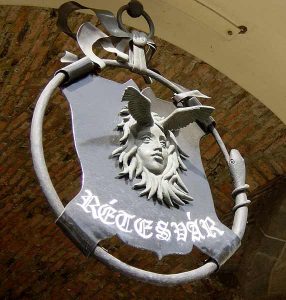Fri 30th May
National Historical Museum
I know where I’m going now – which metro, tram etc…or so I think, until I try and take a short cut up to the castle again (in search of some things I missed yesterday) and hit two dead-ends in quick succession. Doubling back for the second time, I endure the puzzled scrutiny of a raffish
looking bunch of builders working on an apartment block. There’s a lot of cranes about, every street seems to have a house being done-up/over.

It’s only 10ish, and already pretty hot, and I’m feeling tired and stiff, so it’s a relief to reach the top of the hill and gain the cool sanctuary of the National
Historical Museum (housed in yet another wing of the palace). Here I spend an instructive and largely pleasant couple hours randomly filling in some of the holes in my knowledge of Hungarian history (not hard, as you could drive a large truck through pretty well all of them) and dodging school groups. Is it something about Friday, I wonder, as they seem to be everywhere today?
Despite it’s long and varied history (there’s been a royal building here of some sort for centuries, many of which were destroyed…then re-built/re-modelled…most recently in WWII, when most of it was wrecked; it was re-built in 1949 to a consciously anachronistic design dating from 1906) and largely re-built neo-classical exterior, the palace is the nearest thing to a real Tardis I’ve yet come across.

Not only does it seem to contain more museums/galleries/cultural institutions than you can shake a stick at, but they all look completely different inside. I strongly suspect that their aggregate volume is considerably larger than any sane contemplation of the whole conglomeration for the outside would suggest.
The interior of the National Museum of History alone encompasses sombre civic marble, gothic and 18th C chapels, a rather lovely baroque courtyard and some labyrinthine cellars, built on top of the ancient remains of …well, itself, basically.
In contrast, another part of the palace contains the National Library, the entrance lobby to which looks not unlike a very up-market airport departure lounge circa 1974. It’s all very confusing, but also enjoyable.
Mátyás Hunyadi
Stumbling around the cellars looking at bits of previous incarnations of the palace was mildly entertaining, but the real star of the History Museum was an exhibition about Mátyás (pronounced Mathias) Hunyadi – very good indeed. Said mid 15thC Monarch being something of a Hungarian culture-hero, fighting a lot of wars (successfully, on the whole), establishing law codes, wheeler-dealing with the great families of Europe, like the Sforzas in Naples (there was a marriage deal that eventually went astray). He also founded what was considered to be one of the greatest libraries in Europe.
Having said that, one might expect to see a volume or two…so I’m somewhat taken-aback (although delighted) to discover case after case of truly superb illuminated manuscripts. Bibles (of course), treatises on art and architecture, classical texts and commentaries. The incomplete Florentine-made royal bible is particularly breath-taking; lovely text, extremely fine illuminations and gold-leaf aplenty. Here it doesn’t seem out of place.
It all supports Mátyás’ reputation – amongst many other ascribed excellences – as being the local father of the enlightenment, the prototypical Hungarian Renaissance Man. Crossing places are always fascinating,and he seems to have occupied a pretty major one, inheriting (largely due to come clever politic-ing by his father) the mantle of a late Mediaeval Prince at a time of huge political and cultural change.

I’m absurdly pleased to discover why there is a wrought-iron Raven with a gold ring in it’s beak atop a very handsome gate outside. It’s Mátyás’ symbol, from his original family name of Corvinus. Latin for Raven, and also, apparently derived from their occupancy of a region known as Corve. I don’t manage to find out why there’s a gold ring in the beak, though. Frustrating as it’s the sort of detail behind which often lurks a good story.
As a storyteller I’ve long been convinced that the primary building blocks of identity – personal, tribal or national – are the narratives we are continually constructing/re-constructing about ourselves. This exhibition seems to me a very clear example of a conscious attempt to re-construct part of a national narrative, to re-assert a part of their sense of self that has recently been suppressed.

I find it hard to think of this, and then contemplate the Statue Park (which is in some respects telling a rather different story) although the proximate causes, the recent historical events which necessitate the telling of both of these stories and lend them such incredible resonance, are ostensibly the same. It occurs to me that the signs of re-building I’ve been seeing all over the place are also part of the same process of re-definition, carried out on a personal, domestic level.
As a casual visitor (and lacking any personal experience or specialist knowledge) after the fact it’s obviously virtually impossible for me to gain any real sense of the day-to-day reality of the communist regime, and what that meant to those who lived through it. Maybe, though, it is possible to get at least an inkling of the shape of the hole that it’s left – because all of these re-buildings/re-constructions, re-storyings help define the edges of that void.